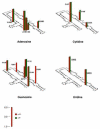2'-Fluoro substituents can mimic native 2'-hydroxyls within structured RNA
- PMID: 21867910
- PMCID: PMC3167488
- DOI: 10.1016/j.chembiol.2011.07.014
2'-Fluoro substituents can mimic native 2'-hydroxyls within structured RNA
Abstract
The ability of fluorine in a C-F bond to act as a hydrogen bond acceptor is controversial. To test such ability in complex RNA macromolecules, we have replaced native 2'-OH groups with 2'-F and 2'-H groups in two related systems, the Tetrahymena group I ribozyme and the ΔC209 P4-P6 RNA domain. In three cases the introduced 2'-F mimics the native 2'-OH group, suggesting that the fluorine atom can accept a hydrogen bond. In each of these cases the native hydroxyl group interacts with a purine exocyclic amine. Our results give insight about the properties of organofluorine and suggest a possible general biochemical signature for tertiary interactions between 2'-hydroxyl groups and exocyclic amino groups within RNA.
Copyright © 2011 Elsevier Ltd. All rights reserved.
Figures


Similar articles
-
Folding mechanism of the Tetrahymena ribozyme P4-P6 domain.Biochemistry. 2000 Sep 12;39(36):10975-85. doi: 10.1021/bi0010118. Biochemistry. 2000. PMID: 10998234
-
The importance of being ribose at the cleavage site in the Tetrahymena ribozyme reaction.Biochemistry. 1993 Aug 17;32(32):8312-21. doi: 10.1021/bi00083a035. Biochemistry. 1993. PMID: 7688573
-
Multiple monovalent ion-dependent pathways for the folding of the L-21 Tetrahymena thermophila ribozyme.J Mol Biol. 2003 Apr 25;328(2):463-78. doi: 10.1016/s0022-2836(03)00247-x. J Mol Biol. 2003. PMID: 12691754
-
Folding mechanisms of group I ribozymes: role of stability and contact order.Biochem Soc Trans. 2002 Nov;30(Pt 6):1166-9. doi: 10.1042/bst0301166. Biochem Soc Trans. 2002. PMID: 12440997 Review.
-
Mapping nucleic acid structure by hydroxyl radical cleavage.Curr Opin Chem Biol. 2005 Apr;9(2):127-34. doi: 10.1016/j.cbpa.2005.02.009. Curr Opin Chem Biol. 2005. PMID: 15811796 Review.
Cited by
-
Transition State Features in the Hepatitis Delta Virus Ribozyme Reaction Revealed by Atomic Perturbations.J Am Chem Soc. 2015 Jul 22;137(28):8973-82. doi: 10.1021/jacs.5b01189. Epub 2015 Jul 14. J Am Chem Soc. 2015. PMID: 26125657 Free PMC article.
-
Gene editing with CRISPR-Cas12a guides possessing ribose-modified pseudoknot handles.Nat Commun. 2021 Nov 15;12(1):6591. doi: 10.1038/s41467-021-26989-z. Nat Commun. 2021. PMID: 34782635 Free PMC article.
-
A revised mechanism for (p)ppGpp synthesis by Rel proteins: The critical role of the 2'-OH of GTP.J Biol Chem. 2020 Sep 11;295(37):12851-12867. doi: 10.1074/jbc.RA120.013636. Epub 2020 Jul 21. J Biol Chem. 2020. PMID: 32719004 Free PMC article.
-
Aminoacyl-tRNA substrate and enzyme backbone atoms contribute to translational quality control by YbaK.J Phys Chem B. 2013 Apr 25;117(16):4521-7. doi: 10.1021/jp308628y. Epub 2012 Dec 6. J Phys Chem B. 2013. PMID: 23185990 Free PMC article.
-
Programmable RNA targeting by bacterial Argonaute nucleases with unconventional guide binding and cleavage specificity.Nat Commun. 2022 Aug 8;13(1):4624. doi: 10.1038/s41467-022-32079-5. Nat Commun. 2022. PMID: 35941106 Free PMC article.
References
-
- Bevilacqua PC, Turner DH. Comparison of binding of mixed ribose deoxyribose analogs of CUCU to a ribozyme and to GGAGAA by equilibrium dialysis: Evidence for ribozyme specific interactions with 2′-OH groups. Biochemistry. 1991;30:10632–10640. - PubMed
-
- Carosati E, Sciabola S, Cruciani G. Hydrogen bonding interactions of covalently bonded fluorine atoms: From crystallographic data to a new angular function in the GRID force field. J. Med. Chem. 2004;47:5114–5125. - PubMed
-
- Cate JH, Gooding AR, Podell E, Zhou K, Golden BL, Kundrot CE, Cech TR, Doudna JA. Crystal structure of a group I ribozyme domain: principles of RNA packing. Science. 1996;273:1678–1685. - PubMed
Publication types
MeSH terms
Substances
Grants and funding
LinkOut - more resources
Full Text Sources
Research Materials

